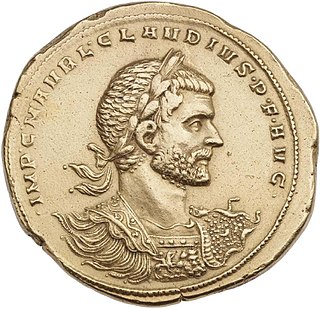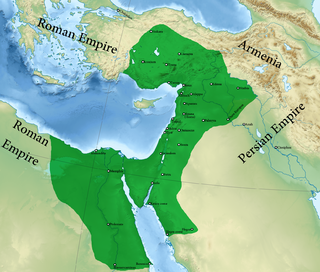
Publius Licinius Egnatius Gallienus was Roman emperor with his father Valerian from 253 to 260 and alone from 260 to 268. He ruled during the Crisis of the Third Century that nearly caused the collapse of the empire. He won a number of military victories against usurpers and Germanic tribes, but was unable to prevent the secession of important provinces. His 15-year reign was the longest in half a century.
The 260s decade ran from January 1, 260, to December 31, 269.

Year 261 (CCLXI) was a common year starting on Tuesday of the Julian calendar. At the time, it was known as the Year of the Consulship of Gallienus and Taurus. The denomination 261 for this year has been used since the early medieval period, when the Anno Domini calendar era became the prevalent method in Europe for naming years.

Marcus Aurelius Claudius 'Gothicus', also known as Claudius II, was Roman emperor from 268 to 270. During his reign he fought successfully against the Alemanni and decisively defeated the Goths at the Battle of Naissus. He died after succumbing to "pestilence", possibly the Plague of Cyprian that had ravaged the provinces of the Empire.

The Gallic Empire or the Gallic Roman Empire are names used in modern historiography for a breakaway part of the Roman Empire that functioned de facto as a separate state from 260 to 274. It originated during the Crisis of the Third Century, when a series of Roman military leaders and aristocrats declared themselves emperors and took control of Gaul and adjacent provinces without attempting to conquer Italy or otherwise seize the central Roman administrative apparatus.

Marcus Cassianius Latinius Postumus was a Roman commander of Batavian origin who ruled as Emperor in the West. The Roman army in Gaul threw off its allegiance to Gallienus around the year 260, and Postumus assumed the title and powers of Emperor in the provinces of Gaul, Germania, Britannia and Hispania, thereby founding what scholars have dubbed the Gallic Empire. He ruled for the better part of ten years before he was murdered by his own troops.

Fulvius Macrianus, also called Macrianus Major, was a Roman usurper. He was one of Valerian's fiscal officers. More precisely, sources refer to him as being in charge of the whole state accounts or, in the language of a later age, as Count of the Treasury and the person in charge of markets and provisions. It seems almost certain that he was an Equestrian. The Historia Augusta claims that he was the foremost of Valerian's military commanders, but that is most likely a gross exaggeration, if not entirely fictitious.

Titus Fulvius Iunius Macrianus, also known as Macrianus Minor, was a Roman usurper. He was the son of Fulvius Macrianus, also known as Macrianus Major.

Titus Fulvius Junius Quietus was a Roman usurper against Roman Emperor Gallienus.

Aureolus was a Roman military commander and would-be usurper. He was one of the so-called Thirty Tyrants who populated the reign of the Emperor Gallienus. Of humble Daco-Roman origins, he was 'made' by the Emperor Gallienus and proved himself to be one of the most brilliant and innovative soldiers of the age. However, he later turned against his benefactor, and was destroyed in the political turmoil that surrounded the Emperor's assassination in a conspiracy orchestrated by his senior officers. The ancient sources which refer to Aureolus are limited and the information they do provide is often contradictory. They include the Historia Augusta, Zonaras' epitome and Zosimus' Historia Nova. His career was most recently summarised in John Bray's biography of Gallienus. The analysis of Aureolus's career given here, especially his final rebellion, is largely based on Bray.
Macriani is the name of three Roman usurpers - a father and two sons - who tried to gain the Roman throne from Emperor Gallienus. All three died in 261 A.D. They were:

Septimius Odaenathus was the founder king (Mlk) of the Palmyrene Kingdom who ruled from Palmyra, Syria. He elevated the status of his kingdom from a regional center subordinate to Rome into a formidable state in the Near East. Odaenathus was born into an aristocratic Palmyrene family that had received Roman citizenship in the 190s under the Severan dynasty. He was the son of Hairan, the descendant of Nasor. The circumstances surrounding his rise are ambiguous; he became the lord (ras) of the city, a position created for him, as early as the 240s and by 258, he was styled a consularis, indicating a high status in the Roman Empire.

Valens Thessalonicus was a Roman usurper during the reign of Emperor Gallienus.
The Gallienus usurpers were the usurpers who claimed imperial power during the reign of Gallienus. The existence of usurpers during the Crisis of the Third Century was very common, and the high number of usurpers fought by Gallienus is due to his long rule; 15 years was a long reign by the standards of the 3rd century Roman Empire.

Piso was probably a Roman general whom the imperial pretender Macrianus Major sent to suppress the governor of Achaia, Valens Thessalonicus. His existence is attested only by the unreliable Historia Augusta, which labels Piso as one of several usurpers who plagued the reign of Emperor Gallienus. While some historians grudgingly regard Piso as a historical figure, many reported details of his life, including his usurpation, are dismissed as fabrications.

The Battle of Edessa took place between the armies of the Roman Empire under the command of Emperor Valerian and Sasanian forces under Shahanshah Shapur I in 260. The Roman army was defeated and captured in its entirety by the Persian forces; for the first time, a Roman emperor was taken prisoner. As such, the battle is generally viewed as one of the worst disasters in military history.

The Palmyrene Empire was a short-lived breakaway state from the Roman Empire resulting from the Crisis of the Third Century. Named after its capital city, Palmyra, it encompassed the Roman provinces of Syria Palaestina, Arabia Petraea, and Egypt, as well as large parts of Asia Minor.
Lucius Petronius Taurus Volusianus was a Roman citizen, apparently of equestrian origins, whose career in the Imperial Service in the mid-Third Century AD carried him from a relatively modest station in life to the highest public offices and senatorial status in a very few years. He may have secured his first appointments before the Licinian Dynasty — — acceded to the Empire in 253 AD, but it was in the course of their reign that his upward progress achieved an almost unprecedented momentum and the second factor seems to have been a consequence of the first. The nature of his relationship to the Licinii is uncertain, but it seems likely that a common origin in the Etruscan region of central Italy at least predisposed Gallienus in his favour and he seems to have been that emperor's most trusted servant and adviser during the period of his sole reign - 260(?)-268 AD.













